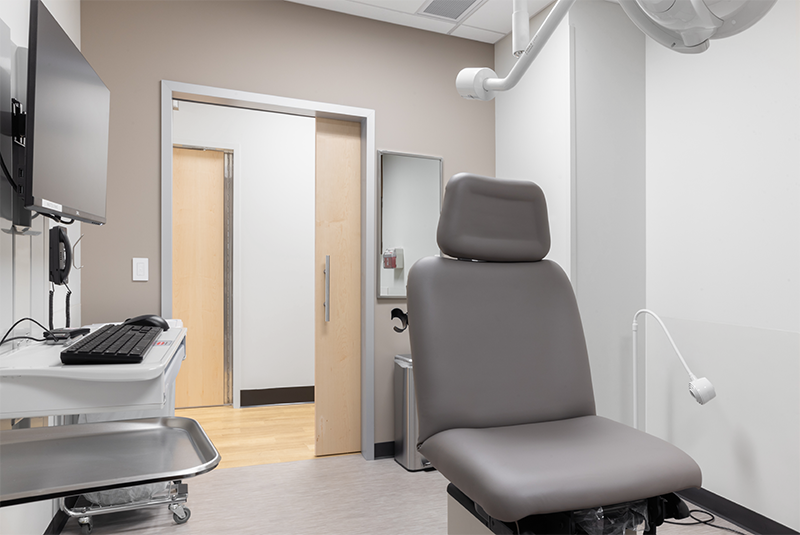
Popularized in a 1984 study on how daylight impacts patient recovery, evidence-based design has expanded to research how almost every aspect of the physical environment can enhance the quality of care within hospitals and other medical centers.
Evidence-based design can be as simple as providing access to daylight and fresh air or as complex as on-stage/off-stage design. While there are many ways to achieve healthcare interior design that improves patient outcomes and staff wellbeing, three trends that help medical facilities provide quality care have emerged: designing for acoustic isolation, creating flexible spaces and the efficient use of a facility’s square footage. When healthcare interior design includes these considerations, it can benefit occupant wellness—both physically and psychologically.
Acoustic isolation improves healthcare interior design
Acoustic isolation not only protects patient-doctor confidentiality, but it can also contribute to staff wellbeing. Noise levels have a direct impact on both patients and providers as well as the design of a building and the materials used to contribute to the overall user experience. Doors are an essential factor as the “openings” are the most acoustically porous. Projects that offer premium acoustic performance capabilities can help medical professionals concentrate on patient care by reducing distracting noises from adjacent areas.
When a part of breakroom design, acoustic isolation can help nurses, physicians and other medical staff rest and recharge—boosting employee satisfaction and reducing the risk of occupational burn out. Commercial sliding doors with drop-down and perimeter seals can offer Noise Isolation Class (NIC) ratings of up to 39 to provide peace and quiet in the rooms that need it the most.
Flexible spaces help create long-lasting medical centers
In addition to acoustic isolation, designing flexible spaces can help medical centers respond quickly to changes in healthcare technology and patient needs. While creating spaces that anticipate change requires attention to almost every detail of a room’s design, doors and openings are often key in healthcare interior design.
This is because opening width largely determines which equipment can be brought in or out of a space. Commercial sliding doors, like ExamSlide, can provide flexible and larger-than-average opening widths without sacrificing useable square footage to swing arc trajectories. As such, they can accommodate the movement of large equipment. Additionally, spaces may require different door qualities depending on location and function, so it is important, when flexible healthcare interior design is a goal, for architects to specify doors that can comply with a broad range of building code requirements.
However, sliding doors are not the only option when designing flexible spaces. Doors with unequal leaves, such as DualSwing, can provide adequate door opening widths for day-to-day use and larger openings for equipment, bariatric wheelchairs, patient beds and more when needed.
Efficient space-use benefits patient and provider
Designing for the efficient use of space can impact several aspects of a patient’s experience. Most immediately, when exam rooms are planned to utilize every square inch of space, they can store more items necessary for care. For example, an on-stage/off-stage design can make patient rooming and care more efficient by creating a floorplan that is easy and intuitive to navigate. This helps ensure a smooth visit whenever care is needed while increasing the amount of face time between medical provider and patient. Further, well-planned exam rooms can often fit all the necessities without greatly impacting the range of motion possible within them, making exam rooms more accessible for those with mobility assistive devices.
Commercial sliding doors can save up to 30 square feet per door by eliminating swing arc trajectories. This can allow exam rooms more area for storage without needing to enlarge the rooms themselves. The enhanced storage capacity has a secondary benefit to healthcare interior design: increasing the number of exam rooms that can fit within a space. More exam rooms allow for greater scheduling flexibility to ease the workload of medical assistants and reduce wait times for patients.
Pacific Medical Centers’ in Renton, Wash., understood commercial sliding doors would allow the designers to plan an extra room for every 11 originally specified without sacrificing room functionality. In fact, these doors contributed so much value across Pacific Medical Centers’ campuses that the Director of Architectural Standards and Design has standardized their use.
Sliding doors contribute to impactful healthcare interior design
There are many elements that make for a successful interior design for healthcare settings. However, doors can provide a key entry point for improving a facility’s interior—both from a patient’s perspective and a provider’s as well. Commercial sliding doors can contribute to a more accessible and navigable building for patients and a better working environment for healthcare providers. And because they are repeated throughout the built environment, their benefits accrue and extend beyond the locations where they are specified.







